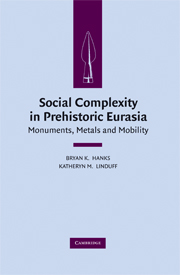Book contents
- Frontmatter
- Contents
- Contributors
- Foreword: From Myth to Method: Advances in the Archaeology of the Eurasian Steppe
- CHAPTER 1 Introduction: Reconsidering Steppe Social Complexity within World Prehistory
- PART ONE FRAMING COMPLEXITY
- PART TWO MINING, METALLURGY, AND TRADE
- CHAPTER 7 Introduction
- CHAPTER 8 Formation of the Eurasian Steppe Belt Cultures: Viewed through the Lens of Archaeometallurgy and Radiocarbon Dating
- CHAPTER 9 Late Prehistoric Mining, Metallurgy, and Social Organization in North Central Eurasia
- CHAPTER 10 The Bronze-Using Cultures in the Northern Frontier of Ancient China and the Metallurgies of Ancient Dian Area in Yunnan Province
- CHAPTER 11 Production and Social Complexity: Bronze Age Metalworking in the Middle Volga
- CHAPTER 12 Early Metallurgy and Socio-Cultural Complexity: Archaeological Discoveries in Northwest China
- PART THREE FRONTIERS AND BORDER DYNAMICS
- PART FOUR SOCIAL POWER, MONUMENTALITY, AND MOBILITY
- Index
CHAPTER 8 - Formation of the Eurasian Steppe Belt Cultures: Viewed through the Lens of Archaeometallurgy and Radiocarbon Dating
from PART TWO - MINING, METALLURGY, AND TRADE
Published online by Cambridge University Press: 26 January 2010
- Frontmatter
- Contents
- Contributors
- Foreword: From Myth to Method: Advances in the Archaeology of the Eurasian Steppe
- CHAPTER 1 Introduction: Reconsidering Steppe Social Complexity within World Prehistory
- PART ONE FRAMING COMPLEXITY
- PART TWO MINING, METALLURGY, AND TRADE
- CHAPTER 7 Introduction
- CHAPTER 8 Formation of the Eurasian Steppe Belt Cultures: Viewed through the Lens of Archaeometallurgy and Radiocarbon Dating
- CHAPTER 9 Late Prehistoric Mining, Metallurgy, and Social Organization in North Central Eurasia
- CHAPTER 10 The Bronze-Using Cultures in the Northern Frontier of Ancient China and the Metallurgies of Ancient Dian Area in Yunnan Province
- CHAPTER 11 Production and Social Complexity: Bronze Age Metalworking in the Middle Volga
- CHAPTER 12 Early Metallurgy and Socio-Cultural Complexity: Archaeological Discoveries in Northwest China
- PART THREE FRONTIERS AND BORDER DYNAMICS
- PART FOUR SOCIAL POWER, MONUMENTALITY, AND MOBILITY
- Index
Summary
My primary goal in this chapter is to determine the general formative stages of Eurasian metallurgical production during the Early Metal Age. In previous publications, I have designated three such stages. Now within the second and the third stages, it is possible to assign a number of successive phases. This research is based on extensive databases of radiocarbon dates of the most ancient metal sites in the region, stored and systematized in the Laboratory of the Institute of Archaeology of the Russian Academy of Sciences in Moscow. These databases have been used to form “metallurgical provinces” (MP) and include more than 120,000 objects. The number of systematically and statistically processed data of calibrated dates (C14) has reached nearly 1,700 analyses. I have attempted to give an account of the role of Eurasia in both the emergence and transmission of metallurgical technology; artifact typologies in western and eastern Asia; and a chronological framework within which other studies, here and elsewhere, can be understood.
The area of concern is vast, and the contacts across it are substantial. What is not outlined in this report is the impact of what I have described chronologically and territorially across such a distance on societal change. This could be seen from the information on metallurgy in several ways. First, if the procurement of ores and production of metal items were instigated by an elite represented by the richest of the grave inventories, we could assume that social inequality was part of the equation.
- Type
- Chapter
- Information
- Social Complexity in Prehistoric EurasiaMonuments, Metals and Mobility, pp. 115 - 145Publisher: Cambridge University PressPrint publication year: 2009
- 13
- Cited by

